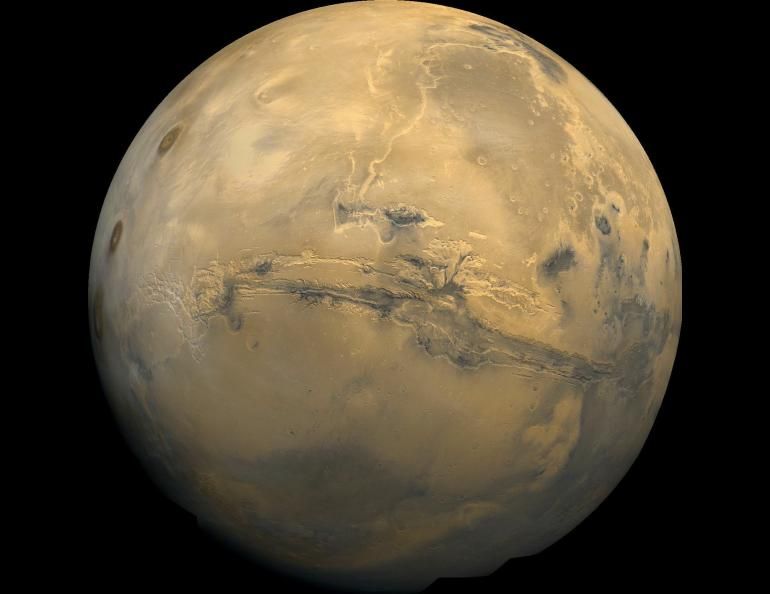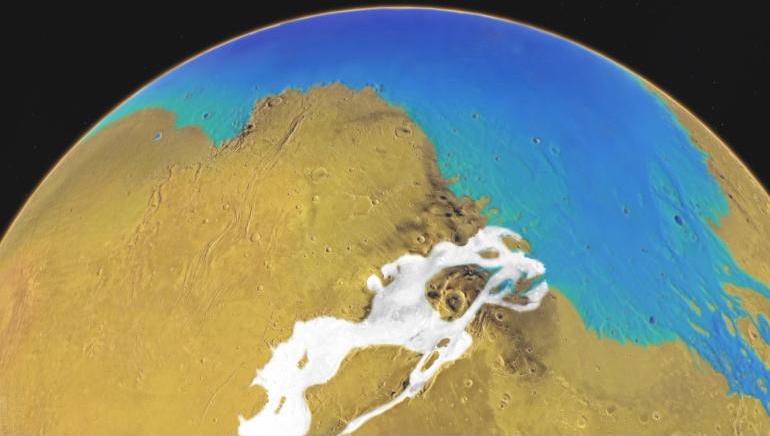Ancient Ocean on Mars
The first use of a novel method of analyzing Mars’ gravitational force supports the idea that the planet once had an extensive northern ocean.
In doing so, the method defines the scope of what scientists refer to as the northern Martian paleo-ocean in more detail.
The work was published in July in the journal Icarus, which is affiliated with the American Astronomical Society’s Division for Planetary Sciences.
The research was led by Jaroslav Klokočník, professor emeritus at the Astronomical Institute of the Czech Academy of Sciences. Gunther Kletetschka, associate research professor at the University of Alaska Fairbanks Geophysical Institute, is among the three co-authors. Kletetschka is also affiliated with Charles University in the Czech Republic.

“A lot of people are excited about water on Mars because there may be life forms that once existed on Mars or maybe exist today in some bacterial form,” Kletetschka said. “We can use this gravity approach to look for water on Mars, because we have done it already on Earth.
“In an area of northern Africa, for example, this gravity approach found a shoreline of a long-ago lake, and its finding was consistent with the archaeological evidence indicating a shoreline of that lake,” he said.
The authors write that analyzing the gravity aspects of Mars to better understand the planet improves upon prior approaches. They note that it can “provide complete information with a better insight of the celestial body, applicable in geology, geophysics, hydrology, glaciology and other disciplines.”

The work by Kletetschka and colleagues differs from the traditional approach of mapping a surface based on gravity anomalies alone.
Gravity anomalies are areas of greater or weaker gravitational force exerted by a planetary body’s surface features. A mountain would exert a greater gravitational force because it has a higher concentration of mass than would be expected on a planet without surface features. Ocean basins and trenches would have less gravitational force.
In their Mars research, the authors used a process developed by Klokočník that analyzes gravity aspects calculated from gravity anomaly measurements. Gravity aspects are mathematical products that characterize the gravity anomalies.
They also used topographic data from the Mars Orbital Laser Altimeter instrument aboard NASA’s Mars Global Surveyor, which launched in November 1996 and mapped the planet for 4 ½ years.
Klokočník used that approach to confirm earlier research about the existence of extensive paleolakes or paleoriver systems under the Saharan sands on Earth. His 2017 research paper also suggested a part of the Grand Egyptian Sand Sea as another candidate for a paleolake.
The gravity aspects method has also been used in a comparison of Earth’s geographic features to those of the cloud-shrouded Venus. That research is described in a July 2023 paper in the journal Scientific Reports in which Kletetschka is a co-author.
Written by Rod Boyce for University of Alaska News
Images by F. Schmidt/NASA - image processing by Jody Swann/Tammy Becker/Alfred McEwen
